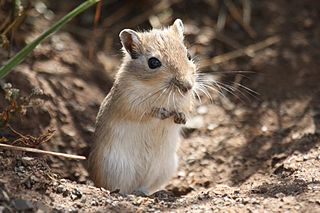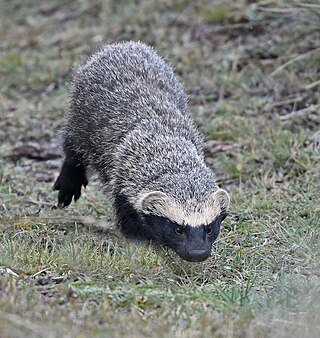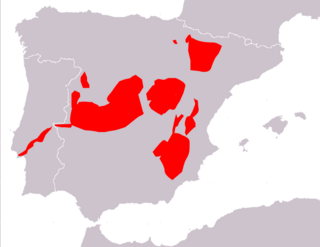
Chinchillas are either of two species of crepuscular rodents of the parvorder Caviomorpha, and are native to the Andes mountains in South America. They live in colonies called "herds" at high elevations up to 4,270 m (14,000 ft). Historically, chinchillas lived in an area that included parts of Bolivia, Peru and Chile, but today, colonies in the wild are known only in Chile. Along with their relatives, viscachas, they make up the family Chinchillidae. They are also related to the chinchilla rat.

The common degu, or, historically, the degu, is a small hystricomorpha rodent endemic to the Chilean matorral ecoregion of central Chile. The name degu on its own indicates either the entire genus Octodon or, more commonly, just the common degu. Common degus belong to the parvorder Caviomorpha of the infraorder Hystricognathi, along with the chinchilla and guinea pig. The word degu comes from the indigenous language of Chile, Mapudungun, and the word dewü, meaning 'mouse' or 'rat'.

The family Chinchillidae is in the order Rodentia and consists of the chinchillas, the viscachas, and their fossil relatives. This family is restricted to southern and western South America, mostly living in mountainous regions of the Andes but one species living on plains. They are medium to large-sized rodents, weighing from 800 g (28 oz) to 8 kg (18 lb), with strong hind legs and large ears and a bushy tail. All species have thick, soft fur, which is considered valuable in some cultures.

The Angora rabbit, one of the most ancient groups of domestic rabbit breeds, which is bred for the long fibers of its coat, known as Angora wool. They are gathered by shearing, combing or plucking. Because rabbits do not possess the same allergy-causing qualities as many other animals, their wool is an important alternative. There are at least 11 distinct breeds of Angora rabbit, four of which are currently recognized by the American Rabbit Breeders Association (ARBA): the English Angora, the French Angora, the Giant Angora and the Satin Angora. Other unrecognized breeds include the German Angora, the Finnish Angora, the Chinese Angora, the Japanese Angora, the Korean Angora, the Russian Angora, the St Lucian Angora and the Swiss Angora.

The Mongolian gerbil or Mongolian jird is a rodent belonging to the subfamily Gerbillinae. Their body size is typically 110–135 mm, with a 95–120 mm tail, and body weight 60–130 g, with adult males larger than females. The animal is used in science and research or kept as a small house pet. Their use in science dates back to the latter half of the 19th century, but they only started to be kept as pets in the English-speaking world after 1954, when they were brought to the United States. However, their use in scientific research has fallen out of favor.

The winter white dwarf hamster, also known as the Russian dwarf hamster, Djungarian hamster, Dzungarian hamster, striped dwarf hamster, Siberian hamster, or Siberian dwarf hamster, is one of three species of hamster in the genus Phodopus. It is ball-shaped and typically half the size of the Syrian hamster, so is called a dwarf hamster along with all Phodopus species. Features of the winter white hamster include a typically thick, dark grey dorsal stripe and furry feet. As winter approaches and the days shorten, the winter white dwarf hamster's dark fur is almost entirely replaced with white fur. In captivity, this does not usually happen as animals maintained as pets are generally housed indoors and exposed to artificial light that prevents the recognition of short winter daylengths. In the wild, they originate from the wheat fields of Kazakhstan, the meadows of Mongolia and Siberia, and the birch stands of Manchuria.

The long-tailed vole, in some areas known as the San Bernardino long-tailed vole, is a small vole found in western North America. They have short ears and a long tail. Their fur is gray brown with light gray underparts. They are around 18 cm (7.1 in) long with an 8 cm (3.1 in) tail and weigh about 50 g (1.8 oz).

A fancy mouse is a domesticated form of the house mouse, one of many species of mice, usually kept as a type of pocket pet. Fancy mice have also been specially bred for exhibiting, with shows being held internationally. A pet mouse is inexpensive compared to larger pets, and even many other pet rodents, but mice are comparatively short-lived: typically only 2 to 3 years.

The lesser grison is a species of mustelid from South America.

The pichi, dwarf armadillo or pygmy armadillo is an armadillo native to Argentina. It is the only living member of the genus Zaedyus, and the only armadillo to hibernate. Fossil remains from the Cerro Azul Formation indicate this species had already evolved during the late Miocene epoch.

The rufous rat-kangaroo or rufous bettong is a small, jumping, rat-like marsupial native to eastern Australia. It is the only species in the genus Aepyprymnus. The largest member of the potoroo/bettong family (Potoroidae), it is about the size of a rabbit. The rufous rat-kangaroo is active at night when it digs for plant roots and fungi, and like other marsupials it carries its young in a pouch. Though its range is reduced, the population is healthy and stable.

The short-tailed chinchilla is a small rodent part of the Chinchillidae family and is classified as an endangered species by the IUCN. Originating in South America, the chinchilla is part of the genus Chinchilla, which is separated into two species: the long-tailed chinchilla and the short-tailed chinchilla. Although the short-tailed chinchilla used to be found in Chile, Argentina, Peru, and Bolivia, the geographical distribution of the species has since shifted. Today, the species remains extant in the Andes mountains of northern Chile, but small populations have been found in southern Bolivia.
The long-tailed dwarf hamster is a species of rodent in the family Cricetidae. It is found in China, Kazakhstan, Mongolia, and Russia.
The montane hylomyscus or montane wood mouse is a species of rodent in the family Muridae. A long-coated species with brownish-grey upper parts and whitish-grey underparts, it occurs in the uplands of tropical Central Africa where its natural habitat is tropical moist montane forests.

Cabrera's vole is a species of vole native to Spain and Portugal. It is named for Ángel Cabrera, a mammalogist then working at the Museo Nacional de Ciencias Naturales in Madrid. It is the only living member of the subgenus Iberomys, although two fossil species are also known, including M. brecciensis, the likely direct ancestor of the living species.

Bennett's chinchilla rat is a species of chinchilla rat in the family Abrocomidae. It is found only in Chile where its habitat is Mediterranean-type scrub on the western side of the Andes. The IUCN has assessed its conservation status as being of "least concern".
The rock dormouse or flat-headed African dormouse is a species of rodent in the family Gliridae. It is found in Botswana, Mozambique, South Africa, Eswatini, Zambia, and Zimbabwe where it lives among rocks in upland areas. It is a fairly common, mainly nocturnal species and the International Union for Conservation of Nature has assessed its conservation status as being of "least concern".

The African pygmy squirrel is a species of rodent in the family Sciuridae. It is monotypic within the genus Myosciurus. It is found in tropical rainforests in Cameroon, the Republic of the Congo, Equatorial Guinea, and Gabon. It is not considered threatened, but likely declines locally due to habitat loss. Together with the least pygmy squirrel of Asia, the African pygmy squirrel is the world's smallest squirrel measuring about 12–14 cm (4.7–5.5 in) in total length and just 15–18 g (0.53–0.63 oz) in weight, which is less than a typical house mouse.

The mountain degu is a species of rodent in the family Octodontidae. It is the only species in the genus Octodontomys. It is found in the foothills of the Andes in Argentina, Bolivia and Chile.

The Pacific pocket mouse, Perognathus longimembris pacificus, is endemic to California. It lives in sandy coastal soils of the coastal sage scrub ecoregion. It eats seeds and some insects. It was believed to be extinct until 1993, when a small population was discovered. It is now a federally listed Endangered animal species.






















